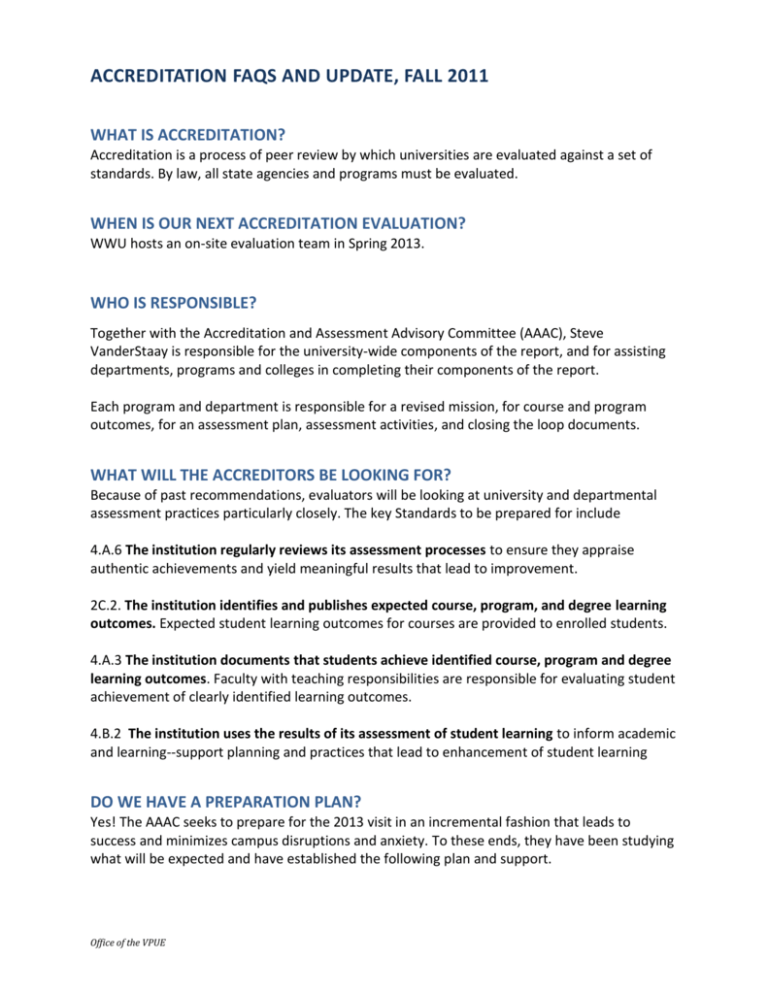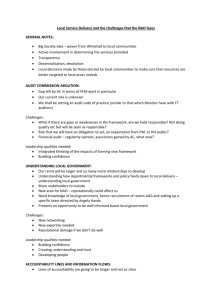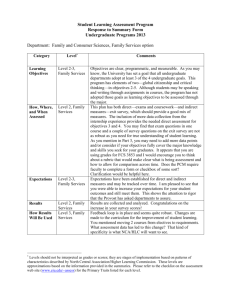what is accreditation?
advertisement

ACCREDITATION FAQS AND UPDATE, FALL 2011 WHAT IS ACCREDITATION? Accreditation is a process of peer review by which universities are evaluated against a set of standards. By law, all state agencies and programs must be evaluated. WHEN IS OUR NEXT ACCREDITATION EVALUATION? WWU hosts an on-site evaluation team in Spring 2013. WHO IS RESPONSIBLE? Together with the Accreditation and Assessment Advisory Committee (AAAC), Steve VanderStaay is responsible for the university-wide components of the report, and for assisting departments, programs and colleges in completing their components of the report. Each program and department is responsible for a revised mission, for course and program outcomes, for an assessment plan, assessment activities, and closing the loop documents. WHAT WILL THE ACCREDITORS BE LOOKING FOR? Because of past recommendations, evaluators will be looking at university and departmental assessment practices particularly closely. The key Standards to be prepared for include 4.A.6 The institution regularly reviews its assessment processes to ensure they appraise authentic achievements and yield meaningful results that lead to improvement. 2C.2. The institution identifies and publishes expected course, program, and degree learning outcomes. Expected student learning outcomes for courses are provided to enrolled students. 4.A.3 The institution documents that students achieve identified course, program and degree learning outcomes. Faculty with teaching responsibilities are responsible for evaluating student achievement of clearly identified learning outcomes. 4.B.2 The institution uses the results of its assessment of student learning to inform academic and learning--support planning and practices that lead to enhancement of student learning DO WE HAVE A PREPARATION PLAN? Yes! The AAAC seeks to prepare for the 2013 visit in an incremental fashion that leads to success and minimizes campus disruptions and anxiety. To these ends, they have been studying what will be expected and have established the following plan and support. Office of the VPUE TIMELINE OF PLAN AND SUPPORT December 20, 2011: All departments review and affirm/revise their missions and program outcomes in light of changes in their disciplines, the new strategic plan, and the goal of a sustainable simplicity (many departments have too many outcomes or outcomes that can’t be assessed). Support: David Bover of Computer Science gave a well-received “how-to” presentation on this topic in the spring and will repeat the presentation this fall on Nov. 9th and 10th. The meeting is open and public. Chairs and assessment coordinators who were unable to attend last spring are strongly encouraged to attend. November 9: 4:00--5:30 CF 314 November 10: 8:30—10:00 CF 225 July, 2012 All programs/depts. review and revise/affirm assessment plans. Support: Barbara Walvoord, an assessment specialist known for working well with faculty and for keeping assessment “Clear and Simple,” is presenting a two-day workshop on creating and improving assessment plans April 19-20th. The April 19th workshop focuses on departmental assessment: “ Goal: participants will emerge from the workshop with a written plan for assessment that is sensible, feasible, useful to the department for its own goals, and consonant with regional and professional accreditation guidelines. Issues addressed: how to establish learning goals, select measures, and use the information. How can the most ineffable goals (e.g. “originality”) be assessed? What are the dangers of assessment? What can assessment do for the department? What is the most basic, no-frills assessment plan?” July, 2012 All departments submit their annual Closing the Loop (CTL) report, describing what they assessed, what they found, and what changes they made in response to the assessment data. Fall, 2012 All programs and departments put their new assessment plans into action, assessing 1/3rd of their program outcomes. Fall 2012 Departments clarify course outcomes and “publish” these in some manner. December, 2012 Departments submit results of Fall assessment to AAAC. December, 2012 Departments make sure their assessment plans and program/course outcomes are accessible on their web site. January, 2013 AAAC writes self-study and submits it to UPRC for approval. February, 2013 Self-Study submitted to NWCCU. Office of the VPUE Mission Statements A Mission Statement is a short, formal, written statement of the purpose of an organization. It should State the overall goal or purpose of the organization Guide the actions of the organization by stating its values Be consistent with the WWU mission State the abilities of the ideal graduate Name the constituencies served by the organization Examples The mission of the Department of Sociology is to provide a high quality educational experience for undergraduate students enrolled at Western Washington University and to contribute to the overall mission of the University through research, scholarship, and service activities. It is also part of the Department’s mission to provide a collegial and enriching environment for the professional growth of its members and associates. Given this mission, the Department is committed to achieving specific goals in three general areas of activity – undergraduate instruction, research and scholarship, and service to the University, professional associations, and the broader community The mission of the Political Science Department is to provide programs that foster critical, independent thinking about politics and public life among our students. Courses provide an understanding of political concepts and the organization and functioning of political systems. Our major programs equip students with the ability to understand political theories and to gain knowledge and experience through written work, lectures, reading, active learning and internships. The department offers courses that are a central part of Western's General University Requirements and that are requirements for other programs and joint majors in the college and in the University. In addition, the department plays an important role in the broader arena of civic education in the university, the community and the state. Program learning outcomes are the knowledge and skills that students can demonstrate by the time they graduate. Program learning outcomes Can be measured. Align with the department mission. Specify content knowledge, skills, attitudes or abilities students can demonstrate. Examples. Students can identify elementary concepts in history such as theories of causation, issues of agency, and periodization. Students write English effectively in a variety of genres. A program assessment plan provides direct measurement of student achievement of the program outcomes. This typically requires anchor papers, rubrics, or standards. Office of the VPUE Office of the VPUE March/April, 2013 WWU hosts the NWCCU on-site evaluation. A Brief History of Recent Accreditation Under old standards 2008 Provisional Accreditation based on progress in 4 areas of recommendation: --Assessment --Transparency and Faculty Participation in Decision Making --Library’s Strategic Plan --Committee Structure Interim report and on-site evaluation required in each area Fall 2010 Interim evaluation and full approval in each area except assessment: While the University has made progress in the implementation of its institution-wide plan of program assessment, the plan is still under development. Similarly, while progress has been made in assessment, there remain some instances where programs are only in the early stage of closing the loop and using the information generated to improve programs and inform resource decisions. It is recommended that the institution continue its efforts to address these issues. New Standards Spring 2011 Recommendations As program assessment capacity is systematized and developed, the institution is encouraged to incorporate more evidence of student learning outcomes data throughout the education experience and within academic programs . . . Office of the VPUE “Closing the Loop” 2011 Please use of the following reporting template for this year’s “closing the loop” (CTL) reporting. The CTL reporting is your annual summary of your department’s assessment activities. The template permits us to record each department’s activities in a consistent manner. We ask you to work with your departmental assessment coordinator to make sure you have assessed 1-2 of your departmental program outcomes via two assessment measures—at least one of which is direct. CTL reports are submitted to your college assessment coordinator. Direct assessment activities measure student performance. They include Any work in a capstone course. A senior level exam, paper, presentation or project that fits a program outcome. Portfolios of student work. Licensing or professional exams. Reports from employers, internship supervisors, etc. Indirect assessment activities measure outcomes via self-reports or surveys. They include the following data. The OSR exit surveys of graduating seniors http://www.wwu.edu/socad/osr/ExitSurveys.shtml The OSR alumni survey http://www.wwu.edu/socad/osr/AlumniSurveys.shtml Departmental time-to-degree data http://west.wwu.edu/factbook/report_page.aspx?rep=DegreeMajors-YrsToDegreeAug2010.pdf&xls=DegreeMajors-YrsToDegree-Aug2010.xls For instance, a department might assess a program outcome by examining senior seminar papers (direct measure) and assess another by looking at departmental data from the senior exit survey (indirect measure). Please use the following template for your reporting. Submit this template with your annual report; we will forward it to the Vice Provost for Undergraduate Education. Departments which seek assistance with this activity are encouraged to contact Steve VanderStaay. Program Outcome Assessed Office of the VPUE Assessment Activity for this Outcome Conclusions reached as a result of the Assessment Activity Modifications in the Program Made as a Result of Assessment Examples: East Asian Studies Direct Measure Program Outcome Assessed East Asian Studies capstone course EAS302 (Methods and Materials in East Asian Studies). This is a seminar thesis paper. Assessment Activity for this Outcome Direct measure: We assessed what the students had learned from the research each conducted during the course, based on comparing their initial thesis plan and sources with the written paper and full list of primary and secondary sources actually used. Conclusions reached as a result of the Assessment Activity Modifications in the Program Made as a Result of Assessment We found that the students had made great progress in developing new skills at finding primary sources. Their use and citation of secondary sources, however, was sometimes incomplete, given the topic chosen. In future we will add a session early in the course that sets the student on track to make a more complete preliminary evaluation of what has already been has previously been published on the topic. English Indirect Measure Program Outcome Assessed Career Advising Office of the VPUE Assessment Activity for this Outcome Indirect measure: Senior Exit Survey Conclusions reached as a result of the Assessment Activity The department decided to increase its effort to provide career advising to students, as students reported that more advising would be welcome. Modifications in the Program Made as a Result of Assessment The department offered several advising sessions that focused on bringing alumni back to campus, including a new speed connections event that brought 15 alumni together with 15 majors in a 2-hour session in May, 2011. • Generic outcomes that should apply to every program and echo GUR competencies: Students can work effectively in teams Students can effectively communicate their ideas in both written and oral form Students understand the moral, social and ethical issues of their work Generic outcomes that may apply to some, but not all disciplines Students understand and follow safe working practices May be relevant to laboratory based programs Students are able to design and implement experiments, analyze results and draw relevant conclusions Discipline-specific outcomes Understanding of core concepts of the discipline Identify a small number (2 or 3) Ability to apply discipline-specific skills and practices Identify a small number (1 or 2) Office of the VPUE







